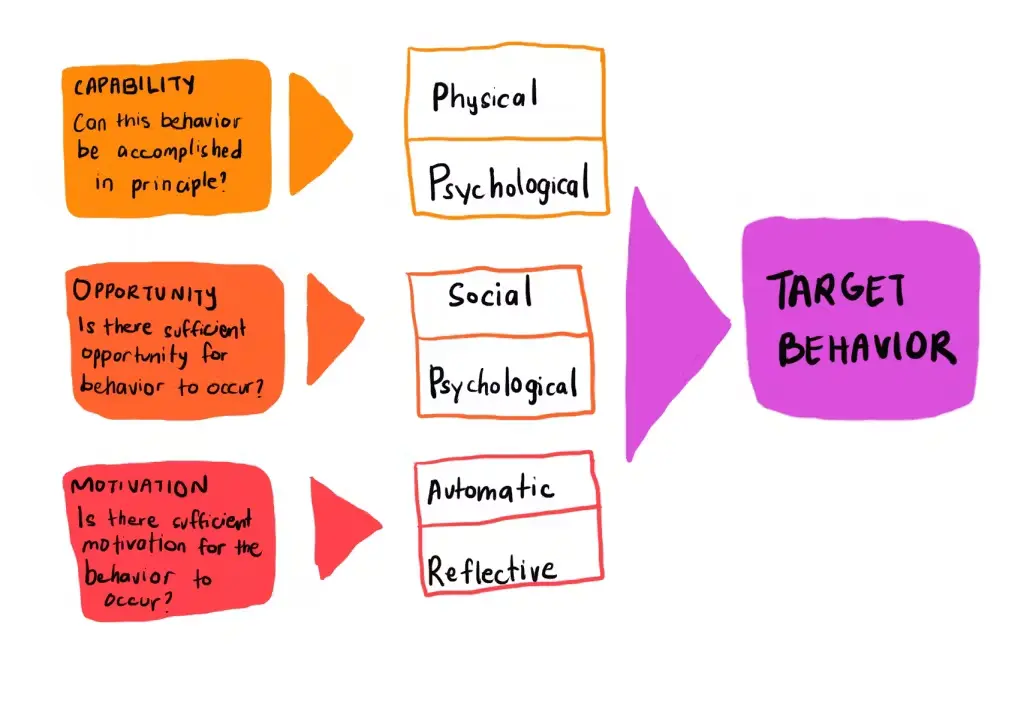If you’re in marketing, you know getting people to act is the endgame. But why do people do what they do—and how can we influence that? That’s where the COM-B model comes in. Understanding these allows you to create campaigns that inspire action, not just clicks.
Contents
-
What is the COM-B Model?
-
Using COM-B
-
Bringing COM-B to Life with the Behavior Change Wheel (BCW)
-
Interventions and Policies
-
How COM-B Can Make Your Campaigns More Effective?
-
Final Thoughts: Why COM-B Works in Marketing
What is the COM-B Model?
If you want to change how people act whether it’s getting a team to work better together, convincing customers to try a new product, or even making changes in consumer behaviour—you need to understand how behaviour works. A great way to start is by learning about the Behaviour Change Wheel (BCW). This tool takes ideas from 19 different models and puts them all together in one easy-to-understand system.
At the centre of the BCW is the COM-B model, which helps explain why people do what they do. The COM-B model says that Behaviour (B) happens when three things come together: Capability (C), Opportunity (O), and Motivation (M). By looking at these three parts, we can understand why behaviour happens and how to make changes that work.
Whether you're trying to get customers to take action or improve your own habits, the COM-B model can help you figure out what’s behind the behaviour and how to create a plan that will make a difference.
Here’s a breakdown of each component:
1. Capability: Can They Do It?
This is about making sure your audience has the knowledge and skills they need. There are two sides to this:
• Psychological Capability: Do they understand what you’re asking them to do? For example, if you’re promoting a fitness application, do they know how to use it? Simple tutorials or demos can help here.
• Physical Capability: Do they have the physical ability? If you’re promoting a fitness class, do people feel confident they can keep up? Providing beginner options or entry-level classes can make it more accessible.
In marketing campaigns: Give people the info they need. Guides, FAQs, or “how-to” videos can boost their confidence and lower barriers to action.
2. Opportunity: Is the Environment Supportive?
Even if someone wants to act, they need the right environment. Opportunity refers to everything around them that can either help or stop them from doing it.
• Physical Opportunity: Does the environment make it easy? For example, promoting a recycling campaign won’t work if bins aren’t easy to find. Or, if you want people to try out a new food item, is it available where they shop?
• Social Opportunity: Social factors matter too. People are more likely to try something if those around them are doing it too. Social norms, peer support, and even trends can push people toward action.
In marketing campaigns: Remove external barriers and make it convenient. If you’re launching a product, ensure it’s in places where your audience shops or offers online delivery.
3. Motivation: Do They Want To?

This is the heart of it— Motivation. Do they feel inspired enough to take action?
• Reflective Motivation: This is the logical side, where people weigh benefits. For example, if you’re promoting a fitness app, people may consider the health benefits of staying active.
• Automatic Motivation: This includes emotions, habits, and impulses. Sometimes, we act because something simply *feels* good or is an easy habit.
In marketing campaigns: To motivate people, appeal to both logic and emotion. Success stories, testimonials, or visuals that connect on an emotional level can help make your product or cause feel essential.
Using COM-B
COM-B is at the centre of the Behaviour Change Wheel. It includes three important parts that affect how people behave. For many situations, the COM-B model alone can help you make changes. But if you want to understand more, you can look at two sub-elements for each part: Capability, Opportunity, and Motivation. Want to go even deeper? You can use the Theoretical Domains Framework (TDF), which has 14 categories to help you understand more about behaviour. Below, you can see how the COM-B sub-elements and TDF work together.

Source: modelthinkers.com/mental-model/com-b-behaviour-change-wheel
Bringing COM-B to Life with the Behavior Change Wheel (BCW)
A person’s behaviour can change if the right steps are taken to make it happen. This model shows that behaviour is influenced by many things, and to change behaviour, you need to adjust at least one of these factors. The COM-B model is especially helpful when planning ways to help people change because it helps make sure the new behaviour lasts. To make it even easier to apply, the COM-B model is often used with the Behaviour Change Wheel, which suggests different ways to encourage people to change their behaviour.

Source: The Decision Lab: The COM-B Model for Behavior Change
Interventions and Policies
The middle circle of the wheel, after COM-B, shows the types of interventions that can help bring about the needed behaviour change. The outer part of the wheel represents different policy areas that these interventions might fall under.
The policy categories include things like planning for the environment and society, communication and marketing, laws and rules, services offered, regulations, financial measures, and guidelines. However, a more practical way to look at it is through the interventions, which we’ve broken down further below:

Source: modelthinkers.com/mental-model/com-b-behaviour-change-wheel
How COM-B Can Make Your Campaigns More Effective?
By addressing Capability, Opportunity, and Motivation, you’re setting your campaign up for success. Here’s a practical example:
Imagine you’re launching a meditation app for people who feel stressed but have never tried meditation.
1. Capability: Offer beginner guides or video demos so users know exactly how to start meditating, even if it’s new to them.
2. Opportunity: Make sure the app is easy to access anytime and offer a free trial so cost isn’t a barrier.
3. Motivation: Use testimonials from people who feel less stressed after using the app. Seeing real results can boost both logical and emotional motivation.
Final Thoughts: Why COM-B Works in Marketing
The COM-B model is more than a theory—it’s a practical tool to understand what drives action. When you break down Capability, Opportunity, and Motivation, you’re building campaigns that don’t just reach people but actually help them take action. It’s about making sure your message sticks and inspires.
At Orange Ideas, we’re all about smart strategies that get results. If you’re ready to create campaigns that make an impact, COM-B can help us turn your big ideas into real action.
